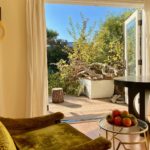Lot size: 300 sq. ft. front garden, 50 sq. ft. parking strip, 600 sq. ft. back garden, 90% native
Garden Age: Garden was installed in stages, beginning in 2015
Years on the Bringing Back the Natives Garden Tour: 5
Showcase Feature
This charming garden is built in the heart of South Berkeley on a small lot, yet designed to feel like an endless, wild, seasonal place in nature. Leslie first wrote about this landscape in her New York Time’s reviewed garden memoir, Cutting Back—My Apprenticeship in the Gardens of Kyoto. She designed her landscape using traditional Japanese garden design principles, and built the garden on a tight budget, purchasing tiny plants and seeds, recycling materials,  and scouting for used furniture. The colorful front “Coastal Garden” has a tropical feel with year-round flowers. The back “Woodland Garden” displays a forest-ringed blue-eyed grass meadow and hidden sitting area. This garden is designed for beauty in all seasons, and features a gurgling bathtub pond that feeds the imagination, firepit built from salvaged pieces of an old driveway,and owl box constructed of reused wood from Leslie’s 114 year old Victorian home. Come meander the wood chip paths in this low maintenance garden, which is never raked or blown and is always naturally pruned, and enjoy the plants that have attracted wildlife, such as a musical cricket and singing Pacific chorus frog.
and scouting for used furniture. The colorful front “Coastal Garden” has a tropical feel with year-round flowers. The back “Woodland Garden” displays a forest-ringed blue-eyed grass meadow and hidden sitting area. This garden is designed for beauty in all seasons, and features a gurgling bathtub pond that feeds the imagination, firepit built from salvaged pieces of an old driveway,and owl box constructed of reused wood from Leslie’s 114 year old Victorian home. Come meander the wood chip paths in this low maintenance garden, which is never raked or blown and is always naturally pruned, and enjoy the plants that have attracted wildlife, such as a musical cricket and singing Pacific chorus frog.
Gardening for Wildlife
Leslie built this landscape as a refuge for people, but it became one for wildlife as well. Berries, such as the pink-flowering current, give birds treats, and keystone, or “super-feeder” plants, such as holly-leafed cherry, provide birds with protein (in the form of insects and caterpillars) all year. The early blooming manzanita provides nectar for pollinators in the winter, and berries for birds in the spring. Coffeeberry flowers furnish bees and twin berry flowers offer hummingbirds nectar. The blue-eyed grass meadow self-scatters seeds for foraging birds. Piles of twigs and leaves create “habitat nests”— attracting the garden’s first cricket, which provides evening concerts in late summer. Near the pond lives a frog that sings for a mate each spring. All habitat plants are labeled accordingly.
Video
“Gardening with California native plants” by Leslie Buck (Zoom-quality video)
Wondering what to make for dinner? Try this great recipe!
Rooreh-Roarin’ Cream of Miner’s Lettuce Soup
Miner’s lettuce makes a delicious, fresh salad, or deep green soup, very similar to spinach salad or soup. Nature acts as the farmer here, since miner’s lettuce grows naturally with winter rains, all through spring, and it regrows every year on its own!

























